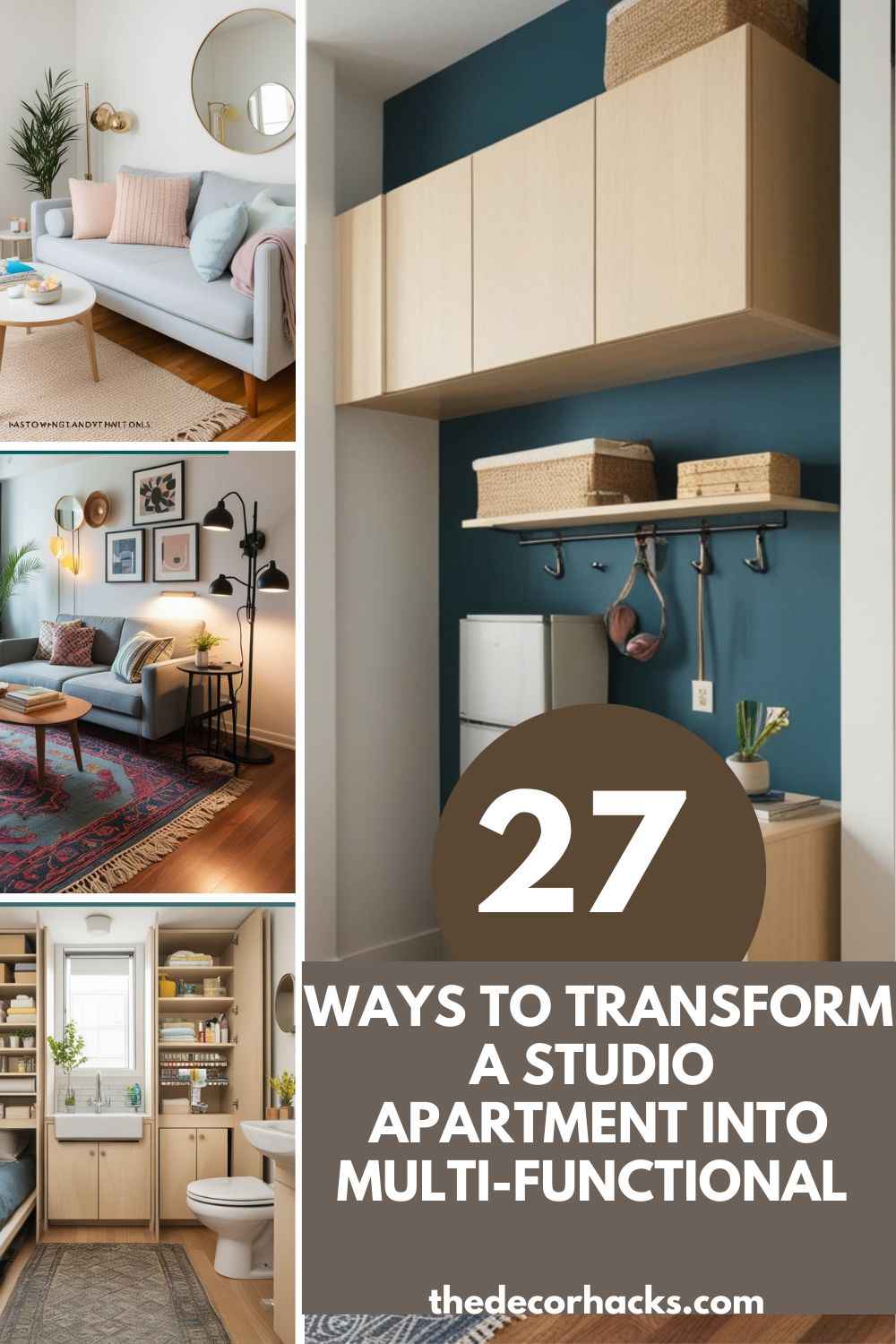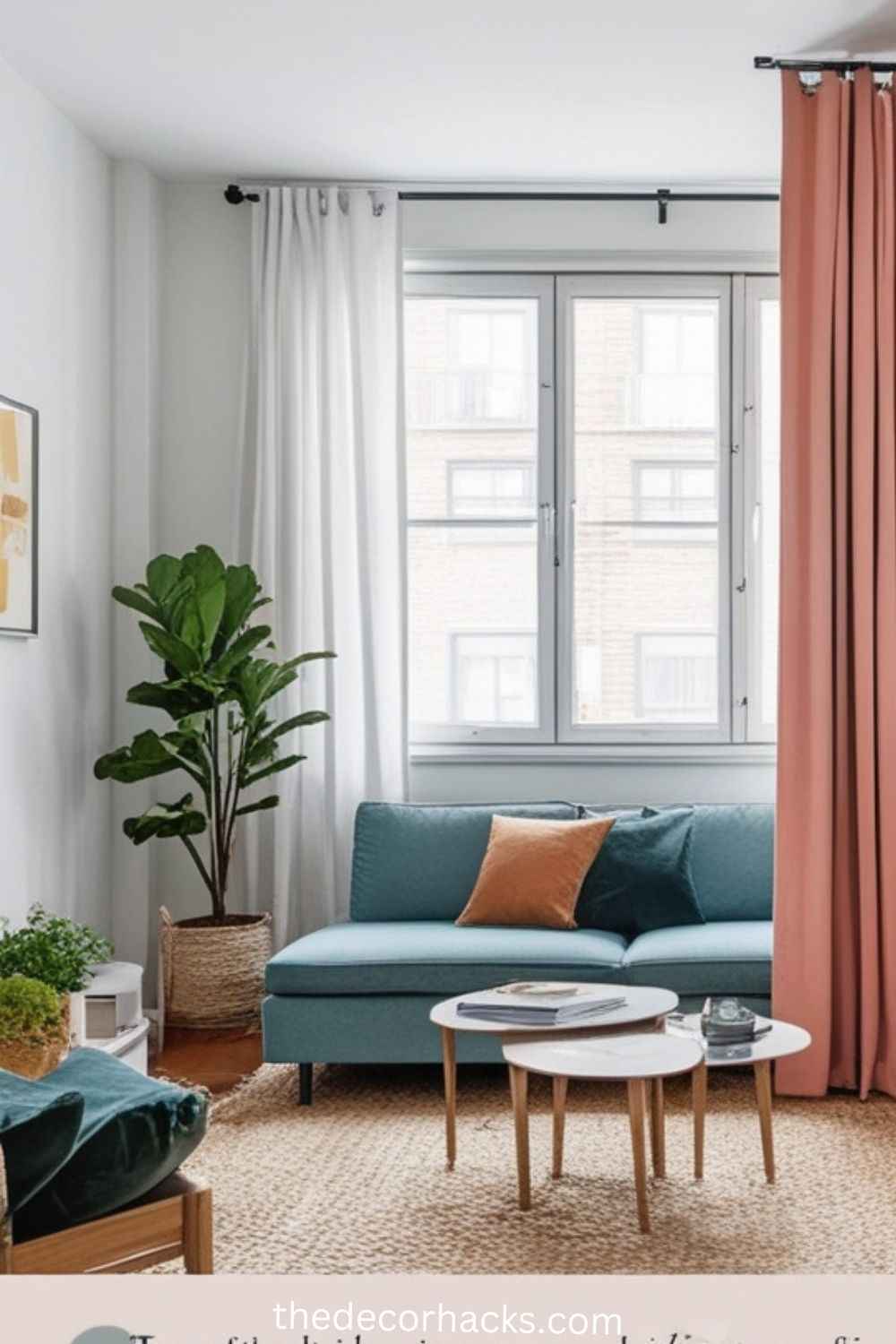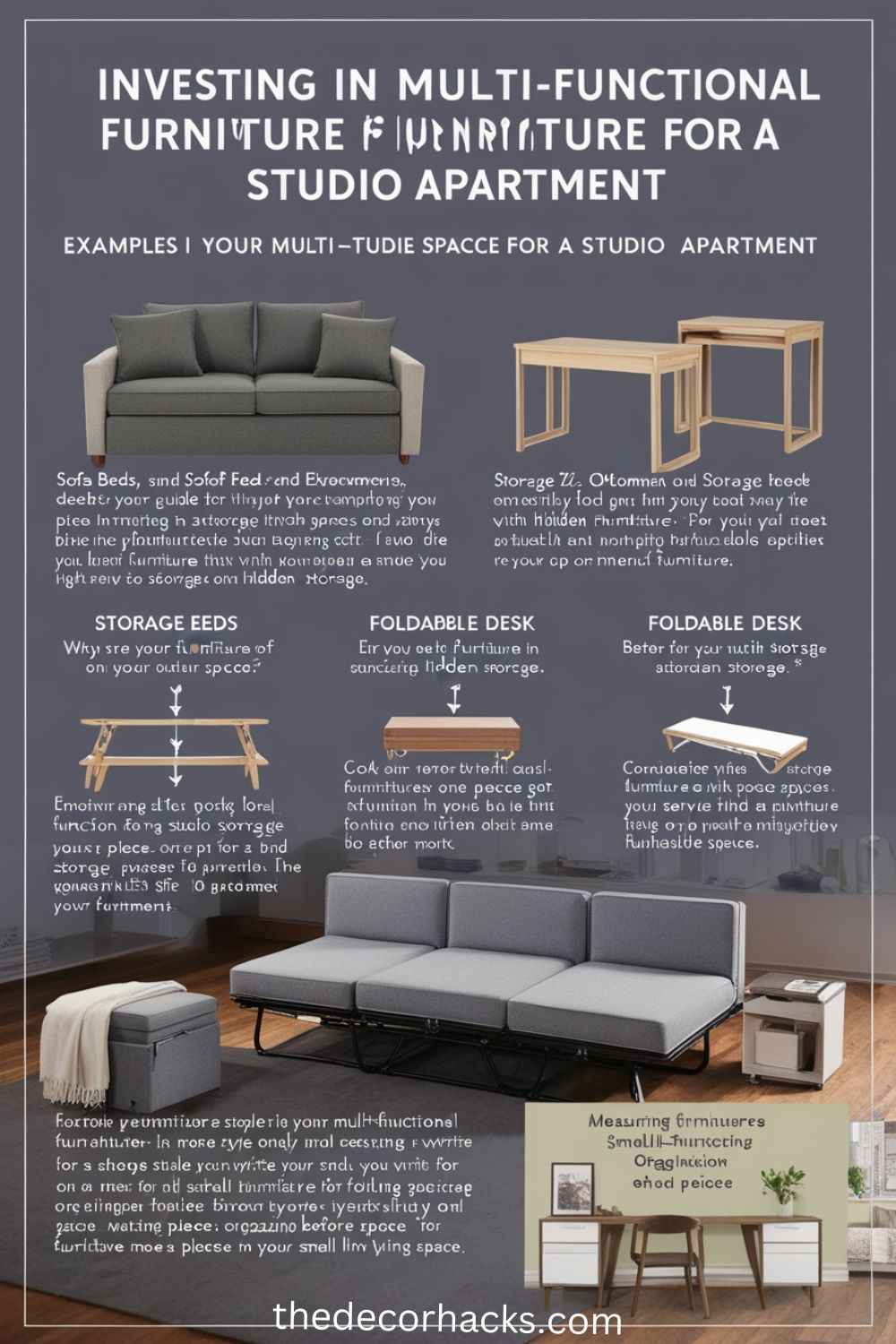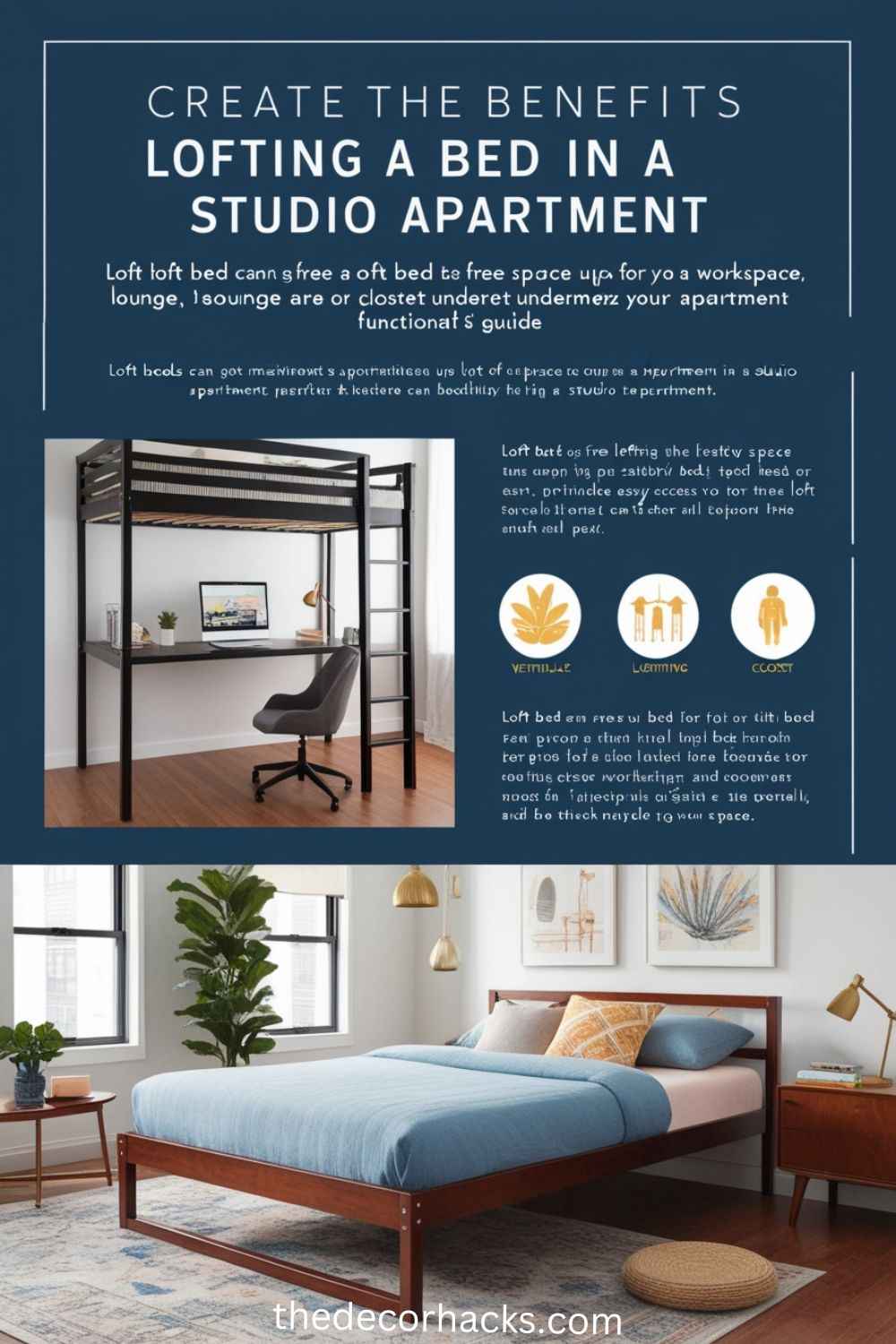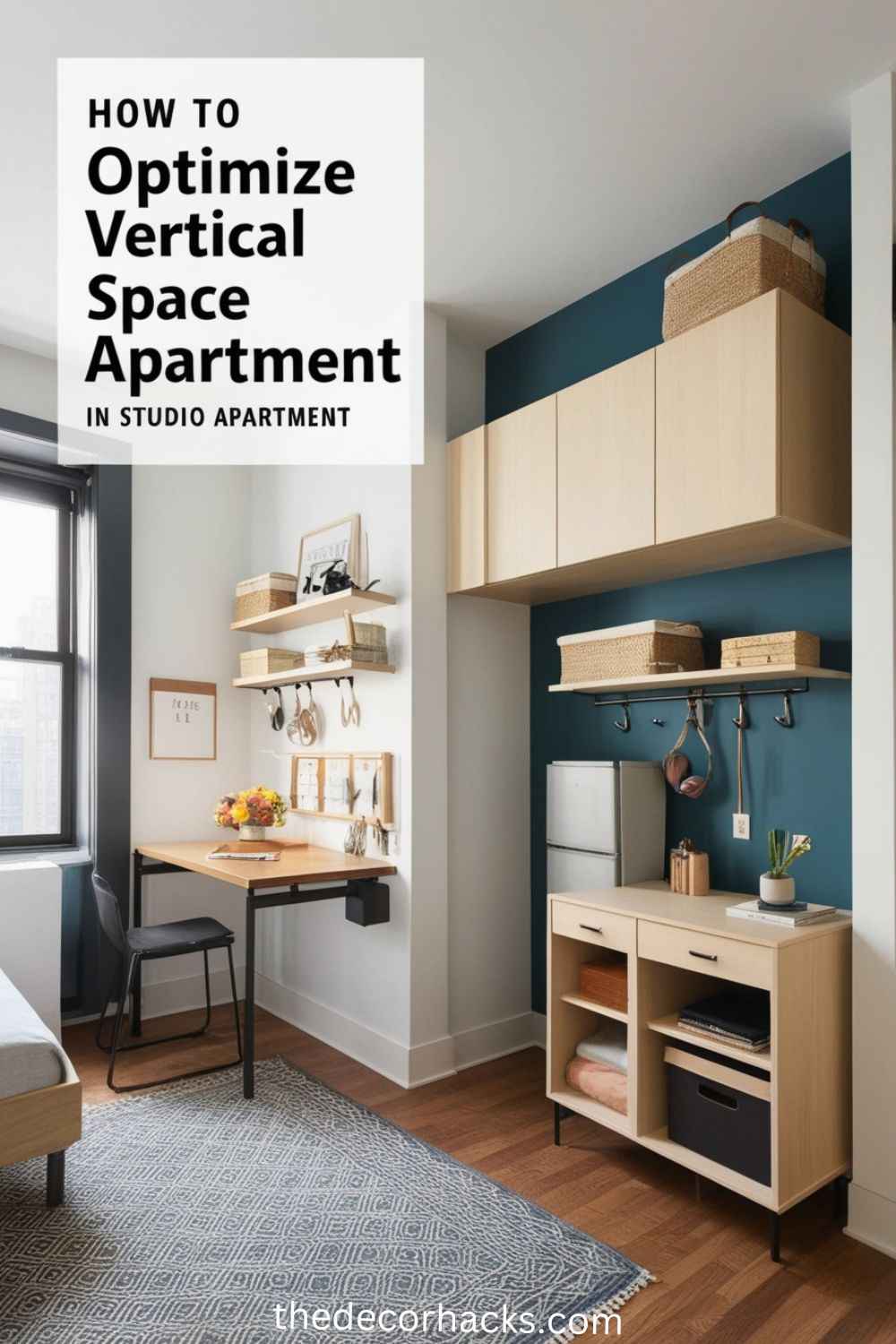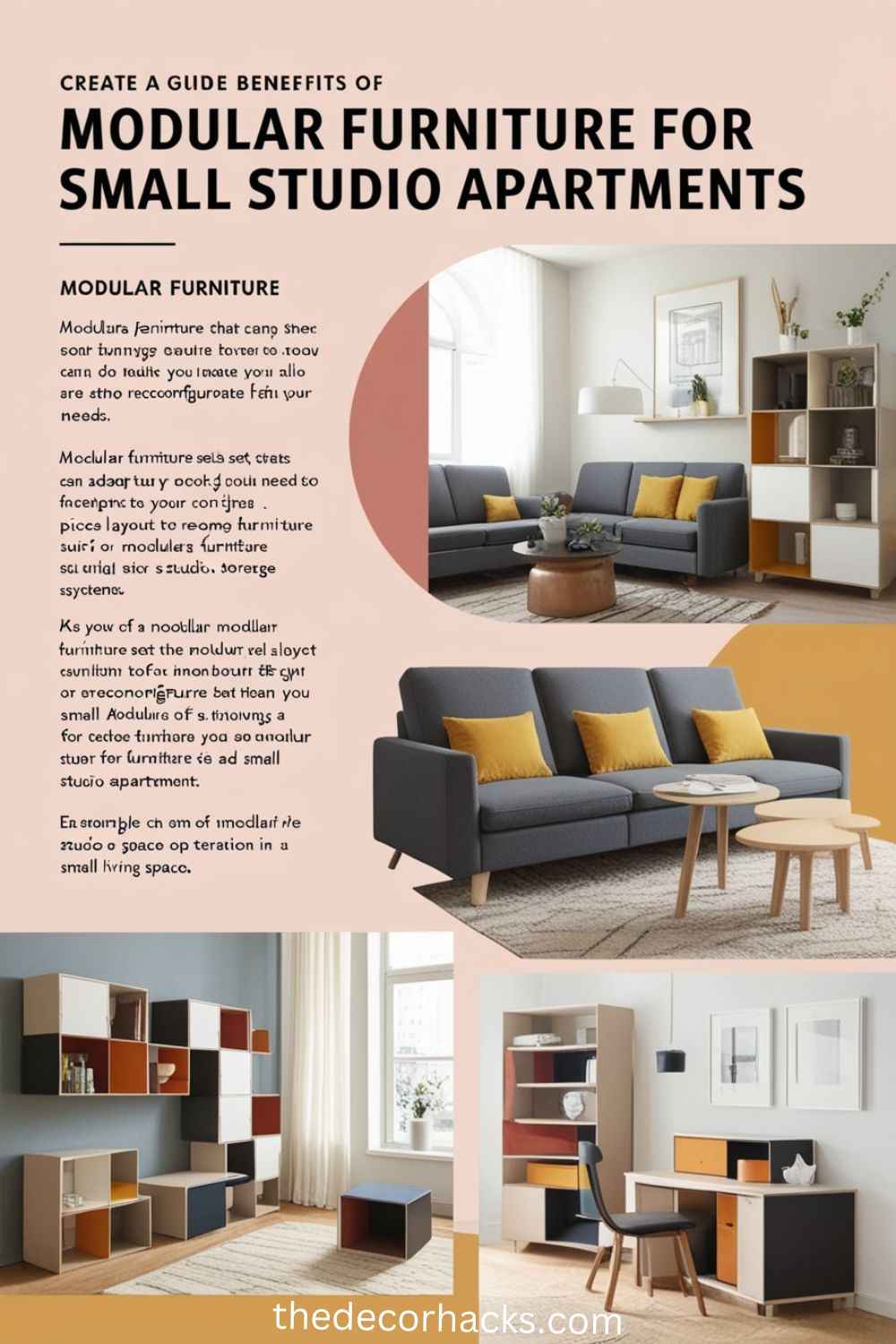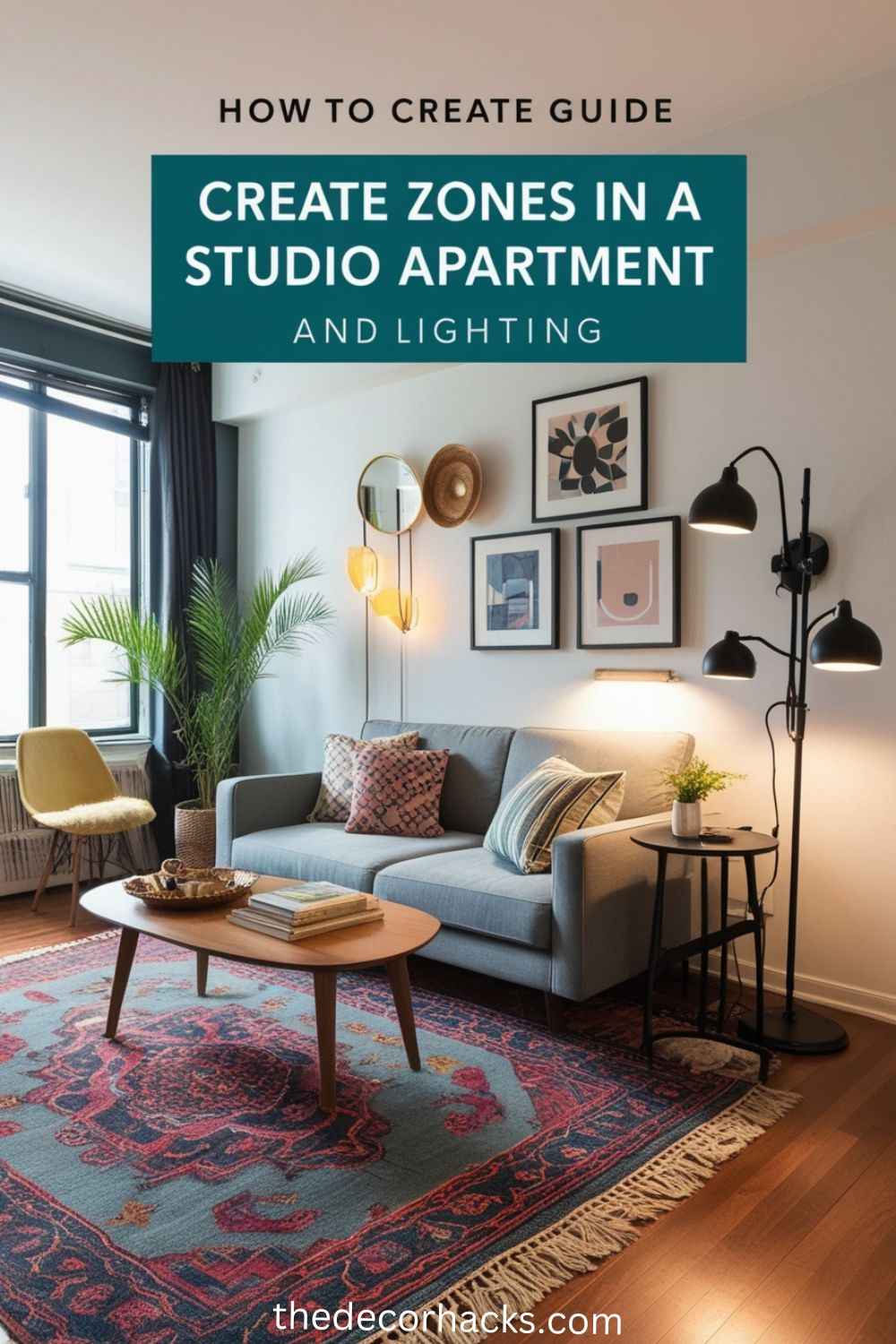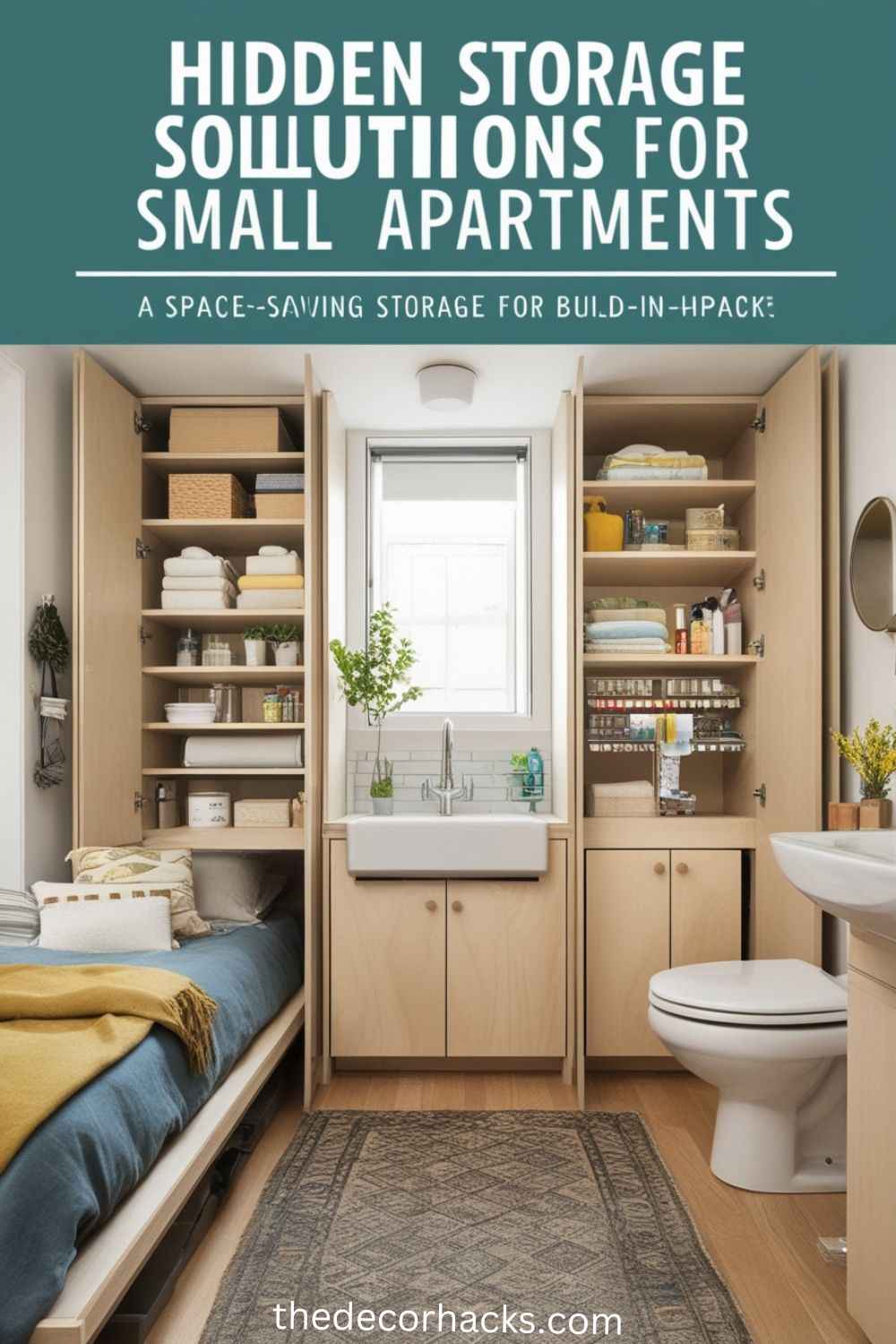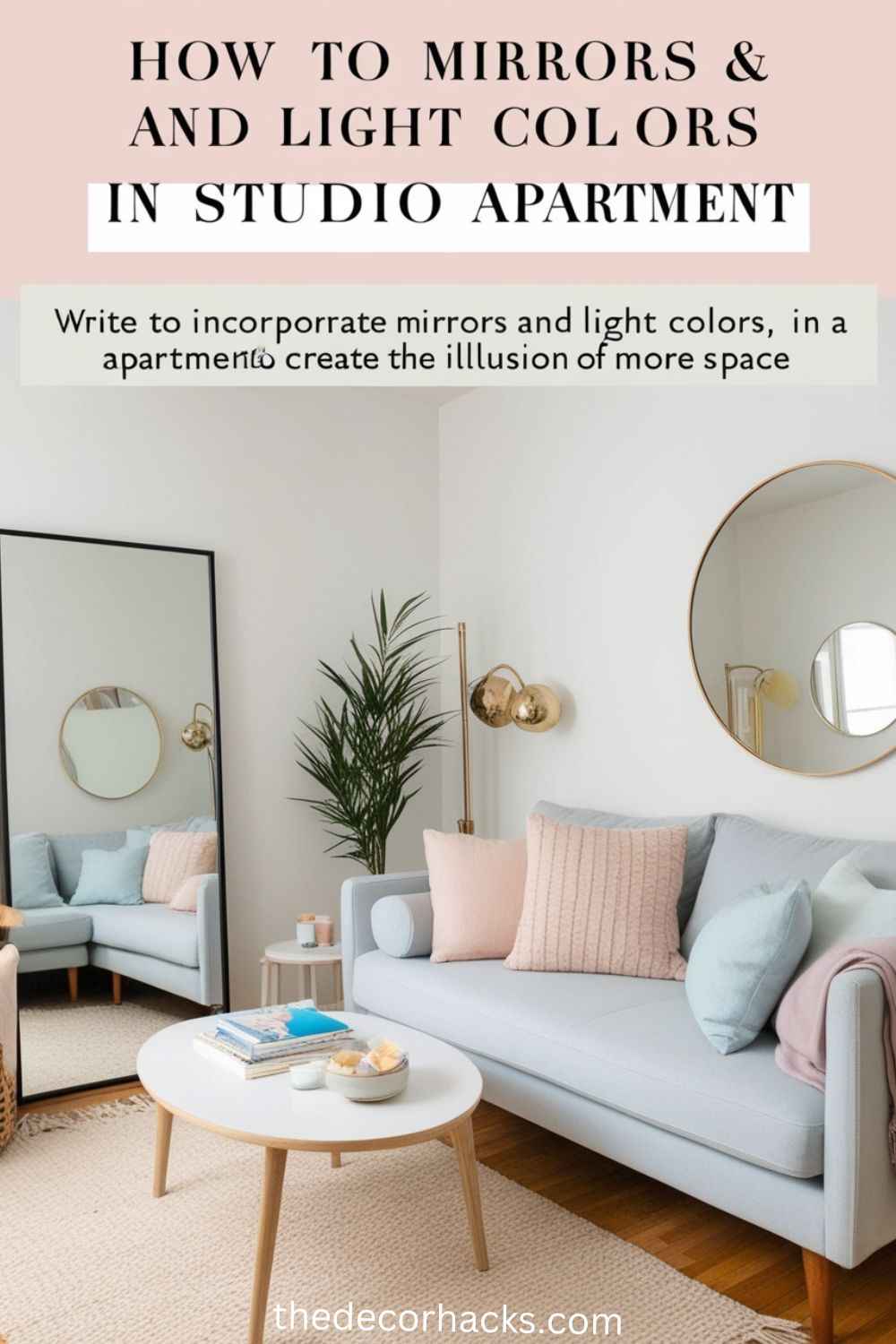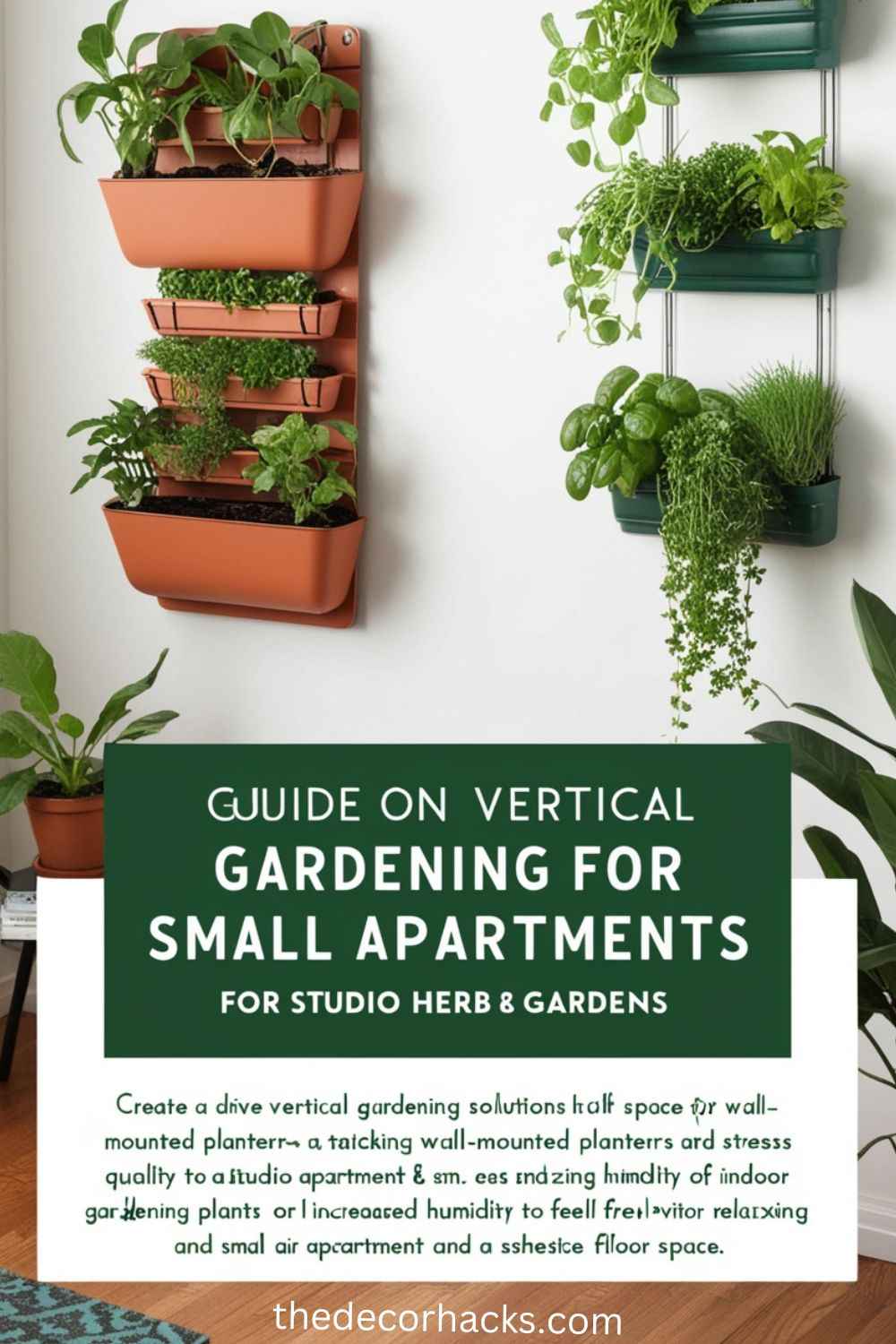In this article, we’ll explore 27 ways to transform a studio apartment into multi-functional spaces. From clever storage solutions to space-saving furniture ideas, these tips will help you make the most of your apartment. Whether you’re looking to create a dedicated work area, a cozy dining nook, or just find a way to organize your belongings, these ideas will inspire you to think outside the box and turn your studio apartment into a functional and stylish sanctuary.
Living in a studio apartment presents a unique set of challenges. With limited space, it can often feel like a constant battle to balance comfort, functionality, and style. The lack of separate rooms can make it difficult to define different areas for sleeping, working, and relaxing, which may lead to a sense of clutter and confusion. However, with some creativity and smart design strategies, even the smallest studio can become a comfortable and efficient living space.
Maximizing space and creating multi-functional areas is crucial for studio apartment dwellers. Every square inch counts, and when furniture and layouts are designed to serve more than one purpose, you can transform a small apartment into a versatile, organized home. Multi-functional spaces not only enhance functionality but can also help you maintain a sense of order and spaciousness in an otherwise compact environment.
Ways to Transform a Studio Apartment into Multi-Functional
Use Room Dividers Creatively
One of the most effective ways to transform a studio apartment is by incorporating room dividers. These versatile elements can help define distinct areas within a single open space without the need for permanent walls. Whether you’re working with a living room that doubles as a bedroom or a dining area that also serves as a home office, room dividers can provide both privacy and organization.
Types of Room Dividers:
- Curtains: Lightweight and inexpensive, curtains are an excellent choice for creating temporary separation between spaces. They can be mounted on a tension rod or ceiling track and easily drawn back when you need to open up the space. Curtains come in various colors, textures, and lengths, making them adaptable to any design style. For added flexibility, consider using a curtain that matches your decor to enhance the aesthetic appeal of the room.
- Shelving Units: Open shelving units not only provide storage but also create a visual barrier that separates spaces while still allowing light to flow through. These units are perfect for placing decorative items, books, or plants, giving both functionality and style. A tall shelving unit can serve as a divider between the living area and sleeping space, adding a sense of privacy without blocking the light.
- Folding Screens: A folding screen is a portable and stylish option for dividing a space. These screens come in a variety of materials such as wood, fabric, or metal, and can be easily folded away when not in use. They are ideal for creating temporary boundaries, such as when you need to separate a guest area or work zone from the main living space. Additionally, folding screens can serve as a design focal point, adding texture and personality to your studio.
How Dividers Can Define Spaces Without Permanent Walls:
The beauty of room dividers lies in their ability to define functional areas without the need for costly construction or permanent walls. These dividers create a visual distinction between different zones, such as a sleeping nook, home office, or dining area, while maintaining the overall openness of the space. This flexibility allows you to adapt your studio layout depending on your needs, and they can easily be moved, removed, or swapped out as your living situation evolves.
Room dividers also help improve the flow and atmosphere of your studio apartment by offering a sense of privacy and tranquility. For example, a curtain can hide the bed when it’s time to unwind, while a shelving unit can give you a sense of separation between your workspace and living space. Whether you’re looking to create a more organized and functional layout or simply want to add a bit of personality to your studio, room dividers offer a creative, budget-friendly solution to make the most of your space.
Invest in Multi-Functional Furniture
When it comes to making the most of a studio apartment, multi-functional furniture is a game-changer. Rather than relying on bulky, single-purpose pieces, opt for furniture that can serve more than one role. Not only does this save valuable space, but it also allows you to enjoy a more organized, flexible living environment.
Examples of Multi-Functional Furniture:
- Sofa Beds: A sofa bed is a perfect solution for a studio apartment that needs to serve as both a living room and a bedroom. By day, it acts as a comfortable couch for lounging or entertaining, and by night, it transforms into a cozy bed. Many modern sofa beds also offer built-in storage for bedding, keeping your apartment neat and clutter-free. Look for styles with sturdy mechanisms to ensure easy conversion and long-term durability.
- Storage Ottomans: Ottomans are incredibly versatile. While they can serve as footrests or extra seating, many models come with hidden storage compartments inside. These are perfect for stashing away blankets, pillows, books, or other items that would otherwise clutter your living space. Choose an ottoman that complements your decor and can double as both a functional and decorative piece in your studio.
- Foldable Desks: A foldable desk can make a significant difference in a small apartment. Whether you need a workspace for your computer, a place to pay bills, or a surface for meal prep, a foldable desk offers a convenient solution. These desks can be easily folded and stored away when not in use, making them ideal for spaces where a permanent desk would take up too much room. Some models even include wall-mounted options that fold up vertically, further maximizing your floor space.
Tips for Choosing Furniture with Hidden Storage:
In a studio apartment, finding furniture with built-in storage is key to keeping everything organized without sacrificing space. Here are a few tips for choosing multi-functional pieces with hidden storage:
- Look for Dual-Purpose Furniture: Invest in items that can pull double duty. For example, a bed with drawers underneath can eliminate the need for a separate dresser. A coffee table that doubles as a desk or dining table can further optimize your layout. Many brands now design furniture specifically for small spaces, offering clever storage solutions integrated into every piece.
- Consider Vertical Storage: Don’t overlook furniture that makes use of vertical space. Bookshelves with drawers, cabinets that go all the way to the ceiling, and tall dressers can store a lot of items while taking up minimal floor space. Some even come with hidden compartments or pull-out drawers to conceal everyday items.
- Prioritize Functionality Over Style: While you should still choose pieces that match your aesthetic, the functionality of the furniture should be your top priority. Opt for pieces with easy access to storage, like beds with pull-out drawers or ottomans with a lift-up top. This will ensure that your space remains both stylish and organized.
- Measure Before You Buy: Because space is limited in a studio apartment, it’s essential to measure your furniture carefully before purchasing. Look for compact pieces with storage options that fit within your available space. Be sure to account for both the storage function and how the piece will fit into your overall layout.
By investing in multi-functional furniture, you can significantly improve the usability of your studio apartment. These pieces help streamline your living area, reduce clutter, and ensure that every item has a place. With thoughtful choices, your furniture can not only serve multiple purposes but also enhance the overall design of your small space.
Loft Your Bed
Lofting your bed is one of the most efficient ways to maximize space in a studio apartment. By raising the bed off the floor, you create valuable room underneath that can be used for other functions, such as a workspace, a lounge area, or additional storage. This strategy is particularly beneficial in smaller apartments where floor space is limited and every inch matters.
Benefits of Loft Beds:
- Freed-Up Space for a Workspace: By elevating the bed, you can create a dedicated area underneath for a home office or study nook. This allows you to separate your sleeping area from your work zone, which is essential in a studio apartment where everything is typically combined in one open room. A desk, shelves, and even a comfortable chair can fit easily into this newly created space, helping you stay organized and productive.
- Extra Lounge Area: Lofting the bed also frees up space for a cozy lounge or reading nook. With the extra height, you can create a relaxing retreat with seating such as bean bags, floor cushions, or a small sofa, allowing you to have a designated area for leisure or socializing with guests.
- More Closet and Storage Options: If you’re in need of additional storage space, using the area beneath the lofted bed for clothes, bins, or even a small closet can help keep your studio tidy and organized. You can install shelves, hanging rods, or drawers underneath to store everything from shoes to seasonal items, making the most of the vertical space in your apartment.
Safety and Design Considerations:
While lofting your bed can be a fantastic way to save space, there are a few key factors to consider to ensure safety and comfort:
- Stability and Support: When choosing a loft bed, make sure it has a sturdy frame and is properly secured. A high bed needs to be safe and stable to prevent accidents. Look for a bed with reinforced supports and safety rails if you’re using a ladder or steps to access it. Consider the weight capacity to ensure the bed is strong enough for your needs.
- Accessibility: Consider how easy it will be to get in and out of your lofted bed. For convenience, choose a sturdy ladder or steps that suit your needs and ensure they are securely attached. Some lofted beds come with built-in stairs, which can also double as storage drawers for additional space-saving.
- Headroom and Ceiling Height: Check the height of your ceiling before lofting your bed to ensure there’s enough room for you to comfortably sit up in bed. You don’t want the space to feel too cramped or uncomfortable. Additionally, consider the clearance space under the bed for other uses – you’ll want enough room to walk around and access whatever you’ve placed underneath.
- Ventilation and Lighting: When lofting your bed, it’s important to maintain proper airflow and lighting. Install a light fixture that allows you to easily reach it, such as a wall-mounted or overhead light. Ventilation is also crucial, especially if you’re using the area beneath the bed for a work or storage area. Ensure that the bed doesn’t obstruct windows or ventilation systems.
- Design Aesthetic: Lofted beds can be stylish, so choose a design that complements your studio’s overall decor. Modern lofted beds come in various materials like wood, metal, and even customizable options, allowing you to match your bed to the rest of your space. You can also enhance the look by adding curtains or a canopy around the bed to create a cozy, private sleeping area.
Lofting your bed is a smart way to transform a small studio apartment into a functional and comfortable space. With the right design and safety considerations in place, you can create a multi-functional environment that offers both practicality and style.
Optimize Vertical Space
In a studio apartment, floor space is at a premium, and every inch counts. One of the most effective ways to make your apartment feel more spacious is by looking upward—optimizing vertical space can provide much-needed storage and help you organize your living areas efficiently. By making use of your walls and high ceilings, you can create more room for both functional storage and stylish design.
Ideas for Installing Wall Shelves and Hooks:
- Wall Shelves: Wall-mounted shelves are an excellent way to free up floor space while keeping essential items accessible. Whether you install them above your desk, bed, or kitchen counter, shelves can be used to store books, plants, decorative objects, or everyday items. Floating shelves are particularly popular in small apartments due to their minimalistic design, which doesn’t overpower the room. Consider staggered or corner shelves to make the most of awkward spaces.
- Pegboards: A pegboard is a versatile, customizable storage solution that can be mounted on any wall. Pegboards allow you to organize items like keys, tools, office supplies, or kitchen utensils. The beauty of a pegboard is its ability to adapt to your needs—adjust the hooks and shelves to fit whatever you need to store. This makes it a fantastic option for small, multipurpose areas.
- Hooks and Racks: Wall-mounted hooks and racks are simple yet effective for keeping your studio organized. Install them near the entryway for coats, bags, and hats, or above your desk for organizing headphones, keys, or even office supplies. In the kitchen, hooks can hold mugs, utensils, or pots. Over-the-door racks are also a great option for utilizing otherwise wasted space.
- Wall-Mounted Desks and Fold-Out Tables: For a compact workspace, a wall-mounted desk or a fold-out table is a great solution. These space-saving options can be folded down when you need to work or eat, then tucked away to create more space when not in use. Some designs even include built-in shelves or storage compartments for office supplies.
Utilizing High Ceilings for Storage and Design:
- Tall Cabinets and Shelving Units: If your studio apartment has high ceilings, don’t let that vertical space go to waste. Tall cabinets, bookshelves, or storage units that reach up to the ceiling can help you store items like seasonal clothing, extra bedding, or kitchen supplies. By going vertical, you can keep your studio uncluttered and make the most of every available inch. Be sure to use a step stool to access the upper shelves safely.
- Lofted or Raised Platforms: If your ceiling height allows, consider installing a lofted platform for additional storage or even as a sleeping area. A raised platform can serve as an elevated storage space or house a second-level bed, freeing up the floor area for other uses. This is a great way to create a distinct separation between different living zones in a studio apartment.
- Hanging Storage: Take advantage of the vertical space above your head by using hanging storage options. From hanging baskets to ceiling-mounted rods, you can store items such as shoes, bags, or kitchen supplies. For example, a hanging fruit basket in the kitchen can save valuable countertop space, while ceiling hooks in the living area can hold decorative plants or lighting fixtures.
- Statement Lighting: High ceilings can also be used to create a dramatic effect with statement lighting. A large pendant light or chandelier can add a touch of elegance while emphasizing the height of the room. Alternatively, consider hanging string lights or lanterns to add ambiance and draw attention to the vertical space.
By optimizing vertical space, you can significantly increase both the storage and functionality of your studio apartment. Wall shelves, hooks, and tall units can help you organize and display your belongings, while high ceilings can be used for storage, design, and creating more living areas. The key is to think upwards and take full advantage of the space available, transforming your studio into a stylish, organized, and efficient home.
Modular Furniture and Customizable Layouts
Modular furniture is an essential tool for transforming a studio apartment into a versatile and functional living space. These pieces are designed to be adaptable, allowing you to rearrange, expand, or reduce the layout according to your needs. Whether you’re entertaining guests, working from home, or simply looking for a new arrangement, modular furniture allows you to adjust your space without the hassle of buying new furniture each time your lifestyle changes.
The Flexibility of Modular Pieces to Adapt to Different Needs:
- Customizable Configurations: Modular furniture is typically made up of individual units or components that can be reconfigured in numerous ways. For example, a sectional sofa might consist of separate pieces, such as a chaise lounge, a middle section, and an ottoman, which can be arranged in various formations based on your current needs. This flexibility allows you to easily adjust the layout, creating a layout that works best for different activities, from lounging to hosting guests.
- Expandable and Multi-Purpose: Modular pieces are great for small spaces because they can expand or contract based on the amount of room available. For example, a modular dining table can extend when you have guests over, then be collapsed into a compact form when it’s just you. Likewise, modular shelving units or storage cabinets can be stacked or spread out depending on the available space, allowing you to maximize your storage options.
- Space Optimization: Modular furniture can be specifically chosen to optimize a studio apartment’s layout. Pieces can be strategically placed to create designated zones, such as a seating area, a sleeping area, or a work nook. Since each unit serves a clear purpose, it helps eliminate unnecessary clutter while maintaining a streamlined look.
Examples of Modular Furniture Sets for Small Spaces:
- Modular Sofas: These sofas often consist of individual sections that can be rearranged to create a traditional sofa, a sectional, or even an L-shaped couch. For small apartments, modular sofas can also be paired with storage ottomans or cushions that double as seats or tables. They allow you to create a customized lounge area that suits the size and shape of your space.
- Modular Shelving Units: Modular shelving systems are ideal for maximizing vertical space. These units typically come in stackable or adjustable sections, so you can configure them to fit the width or height of your wall. They can store books, decor, office supplies, or kitchen essentials. Many modular shelving systems are designed to be expandable, allowing you to add more units as your storage needs increase.
- Modular Desks and Workstations: A modular desk system allows you to build a workspace that suits your specific needs, whether it’s for writing, computer work, or crafting. These desks often come with options for built-in storage, such as drawers or shelves, and can be expanded by adding additional components. Some modular desks are also height-adjustable, making them flexible for standing or sitting while you work.
- Modular Storage Units: These are perfect for organizing your space while also serving as multi-functional pieces. Modular storage systems can be used in the living room, bedroom, or kitchen and often include drawers, open shelving, or baskets that can be customized based on your storage needs. These units can be mixed and matched to fit any space and provide ample storage without taking up too much room.
- Foldable or Stackable Tables: Modular tables that fold or stack are great for making the most of your space when not in use. For example, a folding dining table can expand when needed and collapse into a compact form when you’re not entertaining. Stackable tables can be used as additional seating, a workspace, or a coffee table and easily stored when more space is required.
Modular furniture offers unmatched versatility for studio apartments. The flexibility of these pieces allows you to customize your layout based on your evolving needs while maintaining a clean, clutter-free environment. With the right modular furniture, you can design a space that fits your lifestyle perfectly, maximizing every square inch of your home.
Create Zones Using Rugs and Lighting
In a studio apartment, creating distinct zones for different activities—like living, sleeping, and working—can help organize the space and improve functionality. Without walls to separate these areas, the strategic use of area rugs and lighting is a clever and effective way to define each zone. These elements not only help divide the space visually but also add style and warmth to your home.
Using Area Rugs to Visually Separate Areas:
Area rugs are one of the simplest and most effective ways to create a sense of division in an open-plan space. By placing rugs in different zones of your studio, you can establish clear boundaries between various areas, such as your living room, bedroom, and workspace. Rugs can also help soften the space, making it feel more cozy and inviting.
- Living Area: In the living area, place a large area rug beneath your sofa or chairs to anchor the seating area. This visually separates the living space from other areas, such as the kitchen or bedroom, and creates a comfortable, defined zone for relaxation and socializing.
- Sleeping Area: For the sleeping area, a rug placed underneath the bed can help designate the sleeping space. If your bed is lofted or placed in a corner, a rug can further delineate the area and provide a sense of privacy and comfort. A rug under the bed also adds a luxurious, homely feel and can tie together your bedroom decor.
- Working Area: If you’re using part of your studio as a home office, a rug placed under your desk or office chair can set off the workspace from the rest of the room. This not only helps define the area but also creates a more focused, professional feel, even in the comfort of your own home.
- Layering Rugs for Flexibility: Layering rugs can also be an effective technique for separating spaces. Use smaller rugs within larger ones to create even more distinct zones. For example, in a multifunctional living area, a larger rug can be placed under the main seating, while a smaller rug can define the area near the desk or workspace.
Strategic Use of Lighting to Define and Enhance Zones:
Lighting is another powerful tool for creating visual zones in your studio apartment. Properly placed light sources not only brighten your space but can also highlight specific areas and contribute to the overall ambiance. By using lighting strategically, you can enhance the functionality and mood of each zone.
- Living Area: For the living area, consider using soft, ambient lighting, such as floor lamps, table lamps, or pendant lights. You can also incorporate accent lighting, like wall sconces or LED strip lights, to highlight architectural features or artwork. These lighting elements help draw attention to the living space and create a cozy, relaxed atmosphere.
- Sleeping Area: The sleeping area can benefit from softer, more calming lighting. A pendant light or a set of bedside lamps can provide warm, relaxing illumination. Consider using dimmable lights for flexibility, allowing you to adjust the brightness based on the time of day or the mood you want to create. Task lighting, such as reading lights or wall-mounted lights, can also be useful for nighttime reading without disturbing the rest of the space.
- Working Area: For the workspace, bright, task-focused lighting is essential. Desk lamps, adjustable pendant lights, or even under-cabinet lighting can help illuminate your work area. Consider using a light with adjustable brightness to ensure that you have enough illumination for productivity without overwhelming the space with too much light.
- Accent Lighting: Accent lighting can help define smaller areas or highlight particular features in your studio. Use spotlights or string lights to highlight artwork, plants, or shelves. The added layers of lighting can create a dynamic and personalized feel in your space.
- Dimmer Switches and Smart Lighting: Installing dimmer switches or using smart lighting systems can help you adjust the lighting based on your needs throughout the day. This way, you can have bright, focused light for work during the day, and softer, warmer light in the evening for relaxation.
By using area rugs and lighting thoughtfully, you can create a more functional, organized, and visually appealing studio apartment. Rugs help define each zone by anchoring furniture and providing a sense of separation, while lighting enhances the mood and purpose of each space. Together, these elements allow you to establish distinct areas within your open floor plan without the need for walls, helping you to make the most of every inch of your studio apartment.
Hidden Storage Solutions
When living in a studio apartment, finding ways to store your belongings efficiently is key to maintaining a clutter-free space. Hidden storage solutions allow you to maximize your space without compromising style. From under-bed storage to built-in cabinets, these ideas can help you keep your apartment organized and functional. Additionally, small kitchens and bathrooms often pose unique storage challenges, but with a little creativity, even these areas can be transformed into highly organized, space-saving zones.
Under-Bed Storage:
One of the most common yet highly effective hidden storage solutions is utilizing the space under your bed. Since the bed is often the largest piece of furniture in a studio, making the most of the space beneath it can greatly enhance your apartment’s organization.
- Storage Bins and Drawers: Invest in low-profile storage bins or drawers that can easily slide under the bed to store seasonal clothing, extra bedding, or personal items. Choose bins with wheels for easy access, or opt for rolling drawers to hide away clutter.
- Storage Lift Kits: If your bed doesn’t have built-in storage, consider purchasing a bed lift kit, which raises the bed higher off the ground, allowing for larger bins or even a small dresser underneath. This solution provides ample space for storing things like shoes, luggage, or cleaning supplies.
- Storage Bed Frames: For a more permanent solution, you can opt for a storage bed frame, which has drawers built directly into the base. These frames are available in various styles and are perfect for hiding away clothes, linens, or anything else you need to store without taking up additional floor space.
Built-In Cabinets and Shelving:
- Custom Built-In Units: For small spaces, custom-built cabinetry can be a lifesaver. Consider built-in shelves, cabinets, or even a closet system that can be tailored to fit the specific dimensions of your apartment. A built-in unit can be designed to fit around windows, doors, or other features in the space, creating hidden storage that seamlessly integrates with your apartment’s design.
- Floating Shelves: In areas where you need vertical storage, floating shelves are a minimalist and stylish solution. Install shelves above the bed, sofa, or kitchen counter to store books, decor, or kitchen items. These shelves appear to “float” and take up less space while offering accessible storage.
- Hidden Compartments: Some furniture pieces, such as couches or coffee tables, have hidden compartments within them. These can be used to store items like magazines, remote controls, or electronics. Additionally, consider furniture with built-in drawers or storage units that don’t immediately appear to be for storage, adding an element of surprise.
Creative Storage Ideas for Small Kitchens:
Small kitchens often lack the storage space to accommodate all your cooking essentials, but creative storage ideas can help you make the most of every inch.
- Pull-Out Pantry or Cabinet Drawers: A pull-out pantry or deep cabinet drawers can be a game changer for organizing spices, canned goods, and kitchen utensils. These units are designed to fit into narrow spaces, such as between the fridge and wall, or underneath counters.
- Magnetic Storage Solutions: Use magnetic strips or magnetic containers on the wall to store knives, spices, or small metal kitchen items. This saves drawer and counter space and keeps your utensils organized and easily accessible.
- Under-Cabinet Hooks and Racks: Install hooks or small racks underneath kitchen cabinets to hang mugs, utensils, or even pots and pans. This utilizes vertical space without taking up valuable counter space.
- Corner Shelves: If your kitchen has corner cabinets, consider installing corner shelves or rotating corner units, which maximize storage space that would otherwise go unused.
Creative Storage Ideas for Small Bathrooms:
Bathrooms in studio apartments are often cramped, but you can make them more functional with creative storage solutions.
- Over-the-Toilet Storage: Use the space above the toilet to install a shelf, cabinet, or tower unit. These can hold towels, toiletries, or cleaning supplies and keep them out of sight.
- Wall-Mounted Baskets or Hooks: Wall-mounted baskets can hold toiletries, towels, or bath accessories. Hooks or racks mounted on the back of the bathroom door can store robes, towels, or robes to free up counter space.
- Under-Sink Storage: Use drawer organizers, bins, or a pull-out organizer under the sink to store cleaning supplies, toiletries, and other bathroom essentials. Adding a tension rod inside the cabinet can help you hang spray bottles or other cleaning tools to save space.
By incorporating hidden storage solutions, you can transform your studio apartment into a highly organized and efficient space. With clever use of under-bed storage, built-in cabinetry, and creative storage ideas for small kitchens and bathrooms, you can maximize every inch of your apartment, making it feel both spacious and functional.
Foldable and Expandable Dining Areas
In a studio apartment, having a designated dining area can be challenging due to limited space. However, foldable and expandable dining areas provide a practical solution to this problem. These space-efficient dining setups allow you to create a functional dining space when needed and tuck them away when not in use. Whether you’re entertaining guests, eating a meal, or working from home, these flexible options offer versatility and maximize the utility of your small space.
Drop-Leaf Tables:
Drop-leaf tables are a classic space-saving solution that can easily be expanded or contracted based on your needs. The table has hinged sides (the “leaves”) that can be folded down when not in use, reducing the table’s footprint. When you need more space, simply lift the leaves to extend the surface area. These tables are perfect for small studios, as they can function as a compact table for one or two people and expand when hosting guests.
- Benefits: Drop-leaf tables offer a versatile solution for dining, working, or crafting. They can be tucked away against a wall or in a corner when not in use, freeing up valuable floor space.
- Placement: These tables work well in kitchens, dining nooks, or against walls. If you want to optimize space, you can place them near windows or use them as an extension of your kitchen counter.
Wall-Mounted Dining Surfaces:
Wall-mounted dining surfaces are ideal for extremely limited space. These tables are attached to the wall and can be folded down when needed. When not in use, they fold up flat against the wall, leaving the space clear for other activities. Some models come with built-in storage or shelves, adding even more functionality.
- Benefits: Wall-mounted dining surfaces are particularly useful in tight spaces where every inch of floor space is crucial. They can be used as a quick dining spot or even as a work surface when you’re not eating.
- Placement: Mounting a dining surface near the kitchen or entryway is ideal, allowing you to use the area for meals or as a multifunctional workspace.
Pull-Out Countertops:
Pull-out countertops are another clever solution to increase your available surface area without occupying permanent space. These counters slide out from under existing countertops, cabinets, or islands, providing extra space for meal prep or dining. Afterward, they can be tucked away to restore your apartment’s layout.
- Benefits: Pull-out countertops are especially useful in kitchens with limited counter space. They can provide a temporary dining area or workspace without cluttering the room.
- Placement: These can be installed under existing cabinets or kitchen islands. The pull-out mechanism is usually simple and convenient, making it easy to set up and store away.
Space-Efficient Seating Options:
When it comes to seating in small dining areas, choosing space-efficient seating options is key to maintaining a functional layout. Traditional dining chairs take up a lot of space, but there are plenty of alternatives that are more adaptable to your needs.
- Foldable Chairs: These chairs are easy to store when not in use, taking up minimal space. They can be folded and tucked away in a closet, under a bed, or even behind a door.
- Stackable Chairs: Stackable chairs allow you to create additional seating when you need it and stack them up to save space when not in use. These chairs are ideal for entertaining guests and can be stored in a small corner or closet.
- Benches: A bench can be a great seating option for small dining areas, as it can accommodate more people while taking up less space than individual chairs. Some benches are designed with storage underneath, further enhancing their space-saving capabilities.
- Ottomans with Storage: Multi-purpose ottomans that function as seating or additional storage are great for smaller dining areas. You can use them for seating while eating or as extra storage for linens, games, or other items.
By incorporating foldable and expandable dining areas into your studio apartment, you can create a functional and flexible Ways to Transform a Studio Apartment into Multi-Functional dining space without sacrificing precious floor area. Drop-leaf tables, wall-mounted surfaces, pull-out countertops, and space-efficient seating options help you maximize your space while ensuring that your dining area is as practical and comfortable as possible.
Incorporate Mirrors and Light Colors
In a small studio apartment, the visual perception of space can make a big difference in how the room feels. Incorporating mirrors and light colors can create Ways to Transform a Studio Apartment into Multi-Functional an illusion of a larger, more open environment. These design techniques not only brighten up a space but also help maximize the feeling of openness, making the studio more inviting and less cramped.
How Mirrors Create an Illusion of Space:
Mirrors are one of the most effective tools in interior design for making small spaces appear larger and more open. When strategically placed, mirrors can reflect light, colors, and even outdoor views, which creates a sense of depth and airiness. Here’s how to incorporate mirrors effectively:
- Reflect Natural Light: Place mirrors across from windows to reflect natural light into the room. This can significantly brighten the space, making it feel more open and inviting. The reflection of light creates the illusion of extra space, especially in rooms with limited natural light.
- Use Large Mirrors: A large mirror can be a statement piece in your studio apartment, making the room appear bigger than it actually is. Consider using a full-length mirror or a large framed mirror to reflect both the room’s features and the outdoors, enhancing the sense of space.
- Mirror Walls or Panels: For an even more dramatic effect, use mirrored panels or mirror wall art to expand the space visually. These can cover a portion of a wall or even an entire wall, providing the illusion of additional space and light.
- Mirrored Furniture: In addition to wall mirrors, consider incorporating mirrored furniture, such as coffee tables, cabinets, or side tables. These pieces reflect light and add a touch of glamour, while helping to keep the space feeling light and airy.
Choosing Light-Colored Palettes to Make the Studio Appear Larger:
The color palette you choose for your studio apartment can have a major impact on how spacious the room feels. Light colors tend to reflect more light, making a room feel bigger and more open, while darker colors absorb light and can make a room feel more confined Ways to Transform a Studio Apartment into Multi-Functional . Here’s how to use light colors to your advantage:
- Neutral Tones: Soft, neutral tones like whites, beiges, light grays, and soft pastels can make a room feel larger and more serene. These shades work well for walls, ceilings, and furniture because they reflect light, creating an illusion of space and openness.
- Monochromatic Schemes: Using variations of a single color (such as different shades of beige or light gray) can make the space feel cohesive and uncluttered, enhancing the feeling of space. A monochromatic color scheme can help the different zones of your studio blend seamlessly into each other, without feeling cramped.
- Light-Hued Furniture and Decor: Choose light-colored furniture and decor pieces, such as a light-colored sofa, chairs, or rugs, to complement the light walls. Opt for materials like wood, glass, or light fabrics that don’t overwhelm the space. Light furniture tends to create a sense of airiness and prevents the room from feeling too heavy or congested.
- Contrast with Accent Colors: While light colors should dominate the overall color scheme, you can use accents of darker or vibrant colors to add contrast and prevent the space from feeling too monotone. Accent pillows, throws, artwork, or small decor items can provide pops of color while maintaining the overall sense of openness.
By incorporating mirrors and light colors, you can effectively create the illusion of a more spacious, open studio apartment Ways to Transform a Studio Apartment into Multi-Functional . Mirrors reflect light and create depth, while light-colored palettes make the room feel airy and expansive. These design techniques not only improve the aesthetic of the space but also enhance the functionality of a small studio, making it feel much larger than its actual square footage.
Vertical Gardening for a Green Touch
Bringing greenery into a studio apartment is an excellent way to create a lively, refreshing atmosphere. However, limited space can make it challenging to incorporate traditional gardens. Vertical gardening offers a clever solution by allowing you to grow plants upward rather than outward. With wall-mounted planters and compact herb gardens, you can transform your studio into a serene, natural environment while maximizing floor space. Indoor plants not only add beauty to your apartment, but they also provide various health and environmental benefits, making them a great addition to any small living space.
Wall-Mounted Planters and Compact Herb Gardens:
- Wall-Mounted Planters: Wall-mounted planters are a perfect solution for adding greenery without taking up precious floor space Ways to Transform a Studio Apartment into Multi-Functional . These planters can be attached to walls, railings, or even fences, allowing you to create a vertical garden of your own. You can use wall-mounted racks or hanging planters to arrange plants in a way that enhances the aesthetic of your studio while maintaining a functional layout.
- Multi-Tiered Planters: Opt for multi-tiered or cascading planters that allow you to grow several plants in one vertical arrangement. These planters can be placed on walls or shelves, taking up minimal space while providing a lush and vibrant display of plants.
- Compact Herb Gardens: Herb gardens are ideal for small apartments, and compact versions can be easily mounted on the walls or placed in narrow windowsills. Herbs like basil, mint, rosemary, and thyme not only add greenery but can also be used for cooking, making them both functional and decorative. Use small containers or a vertical planter to grow your herbs in a convenient and space-saving way.
- Hanging Planters: For a more dynamic design, consider hanging planters from the ceiling. You can hang small pots from decorative hooks or use a macrame plant hanger to add vertical interest to your studio. Hanging planters provide an elegant and efficient way to bring the outdoors inside.
Benefits of Indoor Plants for a Small Living Space:
- Air Quality Improvement: Indoor plants have been shown to improve air quality by absorbing toxins and releasing oxygen. In a small living space, where ventilation might be limited, plants can help purify the air, making your studio feel fresher and healthier.
- Stress Reduction and Well-Being: Studies have shown that having plants indoors can reduce stress and improve mood. The presence of greenery can create a calming environment, making your apartment a more relaxing place to unwind after a busy day. Whether you’re working from home or simply relaxing, indoor plants can contribute to overall well-being.
- Aesthetic Enhancement: Plants naturally enhance the aesthetics of any space. Their vibrant green colors and natural shapes add texture and life to your apartment, complementing your interior design. Vertical gardens can also serve as focal points, drawing the eye upward and creating a more dynamic space.
- Space Efficiency: By using vertical space for plants, you free up floor space, allowing for more room to move around and utilize other areas. Vertical gardens maximize your apartment’s potential and create a sense of depth and openness.
- Natural Humidity: Indoor plants can also help increase humidity levels in a dry apartment, improving air moisture and preventing discomfort from dry skin or respiratory issues.
Incorporating vertical gardening into your studio apartment allows you to bring the outdoors inside while maximizing space Ways to Transform a Studio Apartment into Multi-Functional . Wall-mounted planters, compact herb gardens, and hanging plants provide opportunities for greenery in small areas, enhancing both the aesthetic and health benefits of your home. A touch of nature will make your studio feel more vibrant, fresh, and comfortable, helping you create a peaceful living environment in even the tightest of spaces.
FAQ
1. What is the most effective way to maximize space in a studio apartment?
The most effective way to maximize space in a studio apartment is by incorporating multi-functional furniture, such as sofa beds, foldable desks, and storage ottomans. Ways to Transform a Studio Apartment into Multi-Functional Additionally, utilizing vertical space with shelves and wall-mounted storage can significantly free up floor space.
2. How can I create separate zones in a studio apartment without adding walls?
You can create separate zones using room dividers,Ways to Transform a Studio Apartment into Multi-Functional such as curtains, folding screens, or shelving units. Rugs and lighting can also help visually separate different areas, like the living, sleeping, and working zones.
3. What are some practical multi-functional furniture options for a small studio?
Some practical options include:
- Sofa beds that double as seating and a sleeping area.
- Storage ottomans that provide seating and hidden storage.
- Foldable desks that can be tucked away when not in use.
- Expandable dining tables that can be adjusted based on the number of guests.
4. How can I make my bed more functional in a studio apartment?
Lofting your bed can free up valuable floor space for other functions like a desk, lounge area, or closet. Alternatively, using a bed with built-in storage,Ways to Transform a Studio Apartment into Multi-Functional such as drawers or a lofted structure, can further maximize your apartment’s space.
5. What are the benefits of using mirrors in a small studio apartment?
Mirrors create the illusion of more space by reflecting light and making the room appear larger. Placing mirrors across from windows or light sources helps Ways to Transform a Studio Apartment into Multi-Functional brighten the room and adds depth.
6. Can vertical gardening work in a studio apartment?
Yes! Vertical gardening with wall-mounted Ways to Transform a Studio Apartment into Multi-Functional planters or compact herb gardens is an excellent way to add greenery to a studio apartment without taking up floor space. Indoor plants also improve air quality and create a calming atmosphere.
7. How do I choose the right color palette for my studio apartment?
Light colors such as whites, beiges, and soft pastels make Ways to Transform a Studio Apartment into Multi-Functional the room appear larger and brighter. These tones reflect light, creating an airy feeling. You can add pops of color with accents to prevent the space from feeling too monotone.
8. What are the best seating options for a small dining area?
For space efficiency, consider foldable chairs, stackable chairs, or a bench that can accommodate more peopleWays to Transform a Studio Apartment into Multi-Functional . Ottomans with storage can also be a flexible seating option and help save space.
9. How do I make my studio apartment feel less cramped?
To reduce the feeling of cramping, keep your furniture to a minimum, avoid heavy drapery, and use multi-functional furnitureWays to Transform a Studio Apartment into Multi-Functional . Keep your color palette light, use mirrors to reflect light, and incorporate vertical storage and greenery for a more open and welcoming atmosphere.
10. Are there storage solutions specifically for small kitchens and bathrooms?
Yes, for kitchens and bathrooms, consider using pull-out shelves, under-sink storage, and wall-mounted hooksWays to Transform a Studio Apartment into Multi-Functional . In bathrooms, over-the-toilet shelves or wall baskets can help store toiletries and towels. In kitchens, magnetic storage solutions and hanging racks can save space.

Hi! I’m Meg Yoder, a Pennsylvania-based designer with a passion for brand development and home decor design. Creativity has always been my driving force, whether I’m crafting a cohesive brand identity or reimagining a living space with unique decor hacks.
I created TheDecorHacks.com as a space to share my favorite design ideas, tips, and inspirations. From DIY projects to expert insights, my goal is to help you transform your spaces into something extraordinary—without breaking the bank.
When I’m not busy designing, you can find me exploring vintage markets, experimenting with color palettes, or sipping coffee while sketching my next big idea. Let’s create something beautiful together!
![The Decor Hacks [Trending Decor Design Ideas]](https://thedecorhacks.com/wordpress/wp-content/uploads/2025/01/cropped-the-decor-hacks.png)
